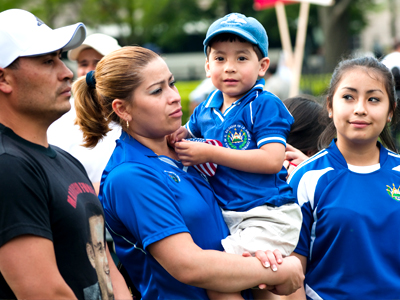
Racial trends shape Bay Area’s future
The San Francisco Bay Area is the nation’s second most diverse region, with growing representation from all major racial/ethnic groups. Fifty-eight percent of residents in the San Francisco Bay Area region are people of color, including many different racial and ethnic groups. Non-Hispanic Whites are the single largest group (42%) followed by Asians (24%) and Latinos (21%). The Latino population is predominately of Mexican ancestry (69%), though a significant proportion are of Salvadoran ancestry (9%).
The Bay Area has experienced significant population growth since 1980, growing from 3.3 million to 4.3 million residents. In the same time period, it has become a majority people-of-color region, increasing from 34 percent people of color to 58 percent people of color. People of color have driven the region’s growth over the past three decades, contributing 97 percent of the growth in the 1980s and driving all growth in the 1990s and 2000s.
All counties in the Bay Area experienced population growth over the past decade, and in every county, the people-of-color population grew at a faster rate than the population as a whole. The two counties in the region with the largest populations (Alameda and Contra Costa) had significantly larger growth in their people-of-color populations compared to their total populations. Alameda County grew 5 percent overall, but the people-of-color population grew more than three times as fast, at 17 percent.
As Alameda County is expected to be home to more people of color over the next 25 years, San Francisco is becoming less diversified. The projected departure of Asians, Latinos and others is expected to reverse a 35-year trend in which people of color became the majority in San Francisco. Whites will again outnumber people of color. The study predicts the black population will remain flat, at about 6 percent.
As San Francisco becomes less racially and ethnically diversified, its surrounding counties — San Mateo, Marin, Alameda and Contra Costa — are expected to become more diverse.
By 2040, seven in every 10 residents of San Mateo, Alameda and Contra Costa County are expected to be people of color, the study states.
Summary findings from the study include:
• Over the past decade, the Bay Area’s Latino population grew rapidly – 28 percent – adding 206,000 residents.
• The region has experienced dramatic growth and change over the past several decades, with the share of people of color increasing from 34 percent to 58 percent since 1980.
• Diverse communities, especially Asians and Latinos, are driving growth and change in the region and will continue to do so over the next several decades.
• The people-of-color population is expected to grow over the next few decades in every county except San Francisco County, where it will decline.
